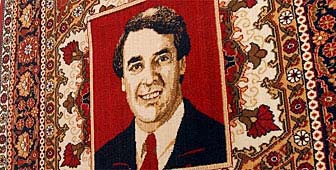Switzerland exhibits its diplomatic gifts

The Swiss Confederation has brought out of its storerooms and cellars a treasure trove of objects for "Diplomatic gifts" - the first exhibition of its kind in Switzerland.
Nearly all the exhibits on view at the Kunstmuseum in Thun were presented to Swiss federal government ministers and officials while on official visits abroad or when receiving their foreign counterparts in Bern.
Some stand out as works of art – although there are one or two objects which come dangerously close to qualifying as kitsch and perhaps tested the diplomatic skills of their receivers when handed over as presents.
However taken as a whole, the exhibition offers a fascinating mix of objects from all over the world, and even the simplest of them reveal a touching desire to make a gift of something which reflects a country’s folkloric traditions.
This is the first time they have been grouped together in a comprehensive exhibition. Individual pieces occasionally adorn public buildings or embassies, but for the most part such gifts are put in storage.
Swiss government representatives and employees are obliged to hand over to the Confederation any presents they receive if their value is estimated at over SFr200 ($120).
Silver palm tree
Highlights of the exhibition include an exquisite porcelain model of a horse and rider, made in Vienna, and silverware. For example, a small silver palm tree from Tunisia manages to dominate the larger objects exhibited around it.
Other eye-catchers are a ship’s clock, presented by the commander-in-chief of the Polish navy, and a western saddle from the state of California.
One the most unusual is a hand-made rug from the Central Asian republic of Kyrgyzstan. It looks like a an example of traditional craftsmanship except for one detail – in the centre of the carpet is a woven portrait of its recipient, former Swiss defence minister, Adolf Ogi.
Madeleine Schuppli, who helped research the exhibition and its catalogue, concedes that some objects are not of high quality in aesthetic terms. “But visitors are finding the mix of objects very appealing,” she added. “And it’s important that they should be exhibited because after all, they belong to us all and we have a right to see them.”
Schuppli says that not surprisingly, Swiss government ministers usually give Swiss watches as gifts to their foreign counterparts: “Adolf Ogi always added a personal gift to the official one. He would give people a piece of rock crystal from the Bernese Oberland, and I think it was a charming gesture to make an inexpensive gift out of a part of one’s country.”
by Richard Dawson

In compliance with the JTI standards
More: SWI swissinfo.ch certified by the Journalism Trust Initiative







You can find an overview of ongoing debates with our journalists here . Please join us!
If you want to start a conversation about a topic raised in this article or want to report factual errors, email us at english@swissinfo.ch.